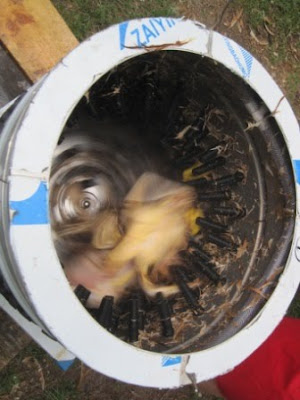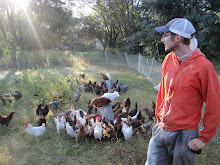
The crates are then loaded into the truck. As farmers, we're happy about this. We've been pulling around those pens every day for 9 weeks.

The birds are then unloaded a few at a time into "kill cones" aka road cones.

With feet up and their heads poking out, a sure hand and a sharp knife cut through the main artery, bleeding the chicken out within 30 seconds. Earplugs not necessary. Elliott's just a wimp.

A photo of the entire layout: Kill cones, scalder, plucker, evisceration table, chill tanks. Aprons and sharp knives are a must. Of course all surfaces are sanitized several times throughout processing.

Once the birds are bled out, the heads are removed. In most countries heads are saved for stock. We put them in our compost pile. However, if anyone's crazy about them we certainly can save them next time!

De-headed bird is dipped in a scalder containing 150 degree, soapy water. We improvised and used a brand new galvanized trash can set on top of a propane burner. It requires a bit of monitoring to keep the temperature at the right place, but it works at this scale. We dipped the birds about 7 seconds each, two at a time.

Wet, soapy bird is then transferred to the plucker for lickety-split feather removal. This was the most expensive part of our facility...but the most worthwhile. 15 seconds with those spinning, rubber fingers gets almost every feather out for two birds at a time.

Whirr...the feathers shoot out into a bucket which is dumped regularly into the compost. Chicken feathers are an excellent source of nitrogen.

It helps if you spray with water while the plucker rotates.

Look at that!

Then to the evisceration table. Step 1, remove feet. Then save in ice cooler for stock. This is Maggie, our current WWOOFer, who became a pro after 3 days of processing.

In a neat, clean (and apparently fun) process, the innards are removed. We take care not to puncture any intestines. Edible organs (livers, hearts, gizzards) are separated, rinsed, and then put into a chill tank separate from the feet. Everything else goes into the "gut" bucket which is periodically emptied into the compost. We compost with wood chips.

Evisceration is the linchpin of processing. It takes lot of practice to work quickly and well. It helps to have multiple people doing it at once.

Working with Maggie is Christine, a community volunteer who came out for two days of processing. She got right in there and was impressed by how much she learned. Christine is a mom who values good, clean, fair food fer her and her children. She has a thyroid issue that propels her to be vigilant in seeking out the best food out there. Eating our chicken and other pasture-raised meats is an absolute necessity for Christine and many of our customers, who are also coping with or recovering from serious illnesses such as cancer, heart disease, diabetes, etc.

Eviscerated, thoroughly rinsed birds are then placed into an ice bath in a chill tank. You want to plunge the internal temperature of the bird to less than 40 degrees as quickly as possible...and it's important to be happy about it!

These are food grade barrels. You want your ice bath to cover your birds thoroughly. This is when the ice was getting low and needed to be replenished.

And voila! Fresh, pasture-raised, farm-processed, clean, good-for-you, local economy boostin', good stewardship supportin', community buildin' chick'n.

Thanks again to the Segal family and the AmeriCorps Alums network for providing the funds to make this facility and the community engagement it will inspire possible.
Arianne















